You are using an out of date browser. It may not display this or other websites correctly.
You should upgrade or use an alternative browser.
You should upgrade or use an alternative browser.
Pedersoli Traditional Hawken Percussion Rifle
- Thread starter 1860 Army
- Start date

Help Support Muzzleloading Forum:
This site may earn a commission from merchant affiliate
links, including eBay, Amazon, and others.
I have had a few that fit so tight in the barrel channel it was a bear. You did remove the ram rod correct?
Dennis Alka
32 Cal.
- Joined
- Jan 27, 2013
- Messages
- 5
- Reaction score
- 0
You have to remove tang screw going to trigger.
Dennis Alka
32 Cal.
- Joined
- Jan 27, 2013
- Messages
- 5
- Reaction score
- 0
With the lock removed I always put a screwdriver with cloth on it under barrel at front of lock and pull up from the back.Yes they do sit in tight.
Dennis Alka
32 Cal.
- Joined
- Jan 27, 2013
- Messages
- 5
- Reaction score
- 0
Once you find a good load you will like that rifle.Mine is in 54 and shoots better than me.
- Joined
- Feb 9, 2015
- Messages
- 3,068
- Reaction score
- 1,044
Congrats on getting your new rifle. :wink:
Would love to see pics. of it.
We always love to see pics.!
Respectfully, Cowboy :thumbsup:
Would love to see pics. of it.
We always love to see pics.!
Respectfully, Cowboy :thumbsup:
Howie1968
40 Cal.
Thats a beautiful rifle
sledjockey
32 Cal.
- Joined
- Apr 27, 2016
- Messages
- 10
- Reaction score
- 0
That looks almost exactly like mine. Is that imported from Italy and manufactured by Investarm? If so, that might be their model 120b.
http://www.investarm.com/eng-avancarica.html
My newest was from "KBI/Kassnar" from the late 1980's and it took me a while to figure out that who actually made it. Found out that several companies import their stuff.
Love mine. Still have to get more than a few hours playing with it. Been dealing with oddities after an engine swap in my truck for the last several months so shooting time has been cut short.
http://www.investarm.com/eng-avancarica.html
My newest was from "KBI/Kassnar" from the late 1980's and it took me a while to figure out that who actually made it. Found out that several companies import their stuff.
Love mine. Still have to get more than a few hours playing with it. Been dealing with oddities after an engine swap in my truck for the last several months so shooting time has been cut short.
Last edited by a moderator:
robinsroost
50 Cal.
I have that same rifle, (120B), that I bought as a kit around 1980. I had the modern rear sight replaced with a buckhorn and the front sight filed down. Mine is a .50 caliber and it is a good shooter with 60 grains of FFFg.......robin :wink:
Last edited by a moderator:
sledjockey
32 Cal.
- Joined
- Apr 27, 2016
- Messages
- 10
- Reaction score
- 0
Thought I would ask since many parts seem to be just imported as X, but really manufactured by Y. The look of it really threw me considering it looks just like mine.
Found an interesting video online about Pedersoli's factory. It is really kind of interesting as to how they make them.
Great looking rifle.
Found an interesting video online about Pedersoli's factory. It is really kind of interesting as to how they make them.
Great looking rifle.
I have both the Pedersoli and the Investarms, both rifles are very good shooters, the Pedersoli has the much better fit and finish as well as being available in left handed configuration.
Here are my experiences of each.
"I had a real treat on Tuesday I had one of Pedersoli's new Traditional "Hawken" Hunter Flintlock Rifle, .50 calibre in true left handed configuration to try out.
This is an interesting development for Pedersoli as it is at the low end of their price range with the L/H version coming in at around £480 in Kranks catalogue and the R/H slightly less.
As a left handed longarm shooter who has been shooting right handed rifles all my life I was particularly interested in trying out a true left handed gun, available at a friendly price and a flintlock to boot. Left handed guns are around but not many production guns are configured this way and those that are have a premium price.
The rifle looks very much like the Investarms "Hawken" that I got last year and reviewed on here. I suspect that Pedersoli has brought out this rifle to compete with the Investarms marketed by Lyman, along with the other budget European "Hawkens" being marketed in the US by the yankee black powder houses.
Of all the Eytie repro houses Pedersoli revel in the reputation of making for the high quality end of the market with production guns of theirs winning the medals in top international competitions. Pedersoli's high quality fit, finish and function is their trademark.
So how does this Pedersoli fair being their first excursion into the budget end of the market?
On initial inspection it stands out as a Pedersoli with the wood to metal finish being excellent especially around the lock and patch box, areas that are forgivably less than perfect on other budget guns, even the patch recess has been well finished inside unlike others that look as if they have been gouged out with a spade. The wood as some figuring, the lock plate has a case hardened finish with the blueing being deep and even. The barrel is octagonal with the ubiquitous 1:48 twist, the muzzle is crowned but it is quiet narrow so care has to be taken when seating patches so as not to nick and hole them. The rifle has buckhorn rear sights and a blade foresight, fortunately these are placed at distance that suit my eyes well so they give me a fine sight picture.
The barrel inside was heavily fouled from the proof house and it took quiet a while with many patches and copious amounts of Aquoil to get it cleaned, but when it was it was bright and shiny with crisp, even rifling that had no tight or rough spots when a tight dry patch was sent down.
It is fitted with a very nice set trigger that gives a crisp, light let off that contributes greatly to the guns grouping ability.
So how does Pedersoli get such quality in at such a low price? If we compare it to the other "Hawkens" in their range like the Rocky Mountain and Missouri models which go for around £250 more these rifles are shorter both in barrel length and in forend length with only one barrel wedge being need as opposed the two in the Missouri and Rocky Mountain models. Savings have been made by using less materials and what must be a simplified manufacturing process. This actually gives a handier rifle that will no doubt appeal once again to the yankee market where such guns are popular for the black powder hunting season.
Now we have have well made and finished gun that fits well and as lefty it is nice to have a cheek rest on the stock that I can use but all this is for naught if it doesn't perform on the target.
To test the rifle I set the target up at 50yrds and shot it benched from a front rest. I decided upon a starting load of 60 grains of Swiss fffg powder under a cast 0.495" lead ball on a 1" diameter 0.015" thick Tanner patch that was dry lubed with Aquoil. I used Swiss Nothing B powder in the priming pan. Sighting was taken with a six-o-clock hold.
Upon initial inspection the lock geometry looked odd in comparison to the accepted norms for good sparking locks, the flint was aligned high on the frizzen and was pointing well beyond the pan when fired, this was regardless of how the flint was fitted. Despite the contravention of accepted theory the lock functioned very well, the Pedersoli geometry gives for a short throw of the cock and I suspect that contributes in no small way to the rifles impressive rapidity of ignition. The flint that came with the rifle looked usable and gave around a dozen or so shots before it shattered, it could not be re-knapped and was replaced with a good quality English black flint which functioned flawlessly for the remaining three dozen or so shots and had plenty of life in it when I had finished, so with with a good flint I would be expecting at least 50 shots from it and no doubt a good many more beyond that. The original flint came seated in the cock jaws with lead sheeting which I retained rather than my usual leather, I suspect that the lead helps with the ignition by adding extra mass which helps with the cocks momentum in its short throw, then again I could just be over thinking it.
Loading was done using a short starter as this patch and ball combination is a tight fit, a Pro Shot black powder, flexible rod and a 50 calibre bp jag was used for all ramming, wiping and cleaning. These rods are excellent and I use them for all my muzzle loading. The rod that comes with the rifle is actually of good quality with the ferrules pinned and threaded for jags, the grain straight and aligned with length of the rod so I would have no hesitation in using it if I had to.
With the first load home it took three pans of priming powder before the first ignition, this was no doubt due to proof fouling lingering in the antechamber of Pedersoli's simplified patent breech. Over the 50 or so shots that were put through the rifle there were only two failures to fire and they were both due to forgetting to the prick the touch hole after seating the main charge.
Between shots the barrel had a barely damp Aquoiled patch put down after the powder followed by a dry patch to keep the bore in a consistent condition, there was no fouling build up and the patched ball seated smoothly each time with the barrel cleaning up at the end of shooting with half a dozen wet and dry patches. Good quality fine grade powder with a tight fitting dry patched ball all leads to efficient ignition and a minimum of fouling to manage.
Here is the target with first six shots, the first shot was high at twelve-o-clock the next two were where I was bringing the sights down with the last three going into the group at nine-o-clock, I was going to tap the foresight over when I noticed that my careless adjusting of the rear sight wedge had jammed over to the left 'tween the rearsight and the barrel thus causing the drift to the left with the first four shots, with this straightened the rifle then shot consistently into the nine ring at nine-o-clock so to get it "on" would only require a slight adjustment of the foresight. The rifle performed to this same point of impact when shot by two left handed shooters and one right hander, groups were "one hole" with all shooters, except for the odd ones out of the groups which in all cases were called by the firers.
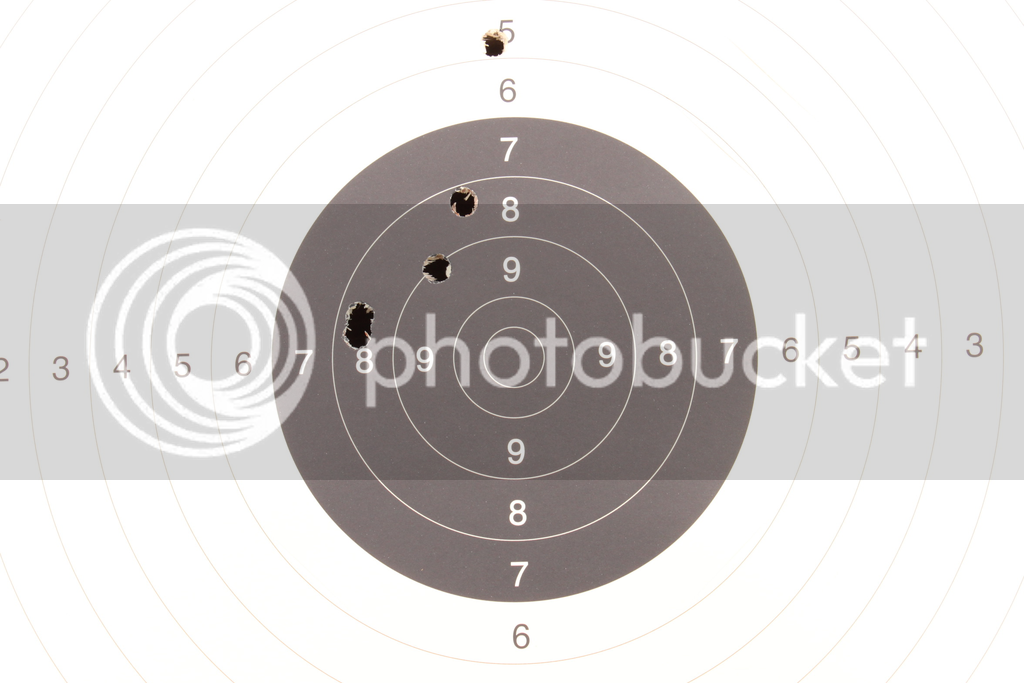
The action.
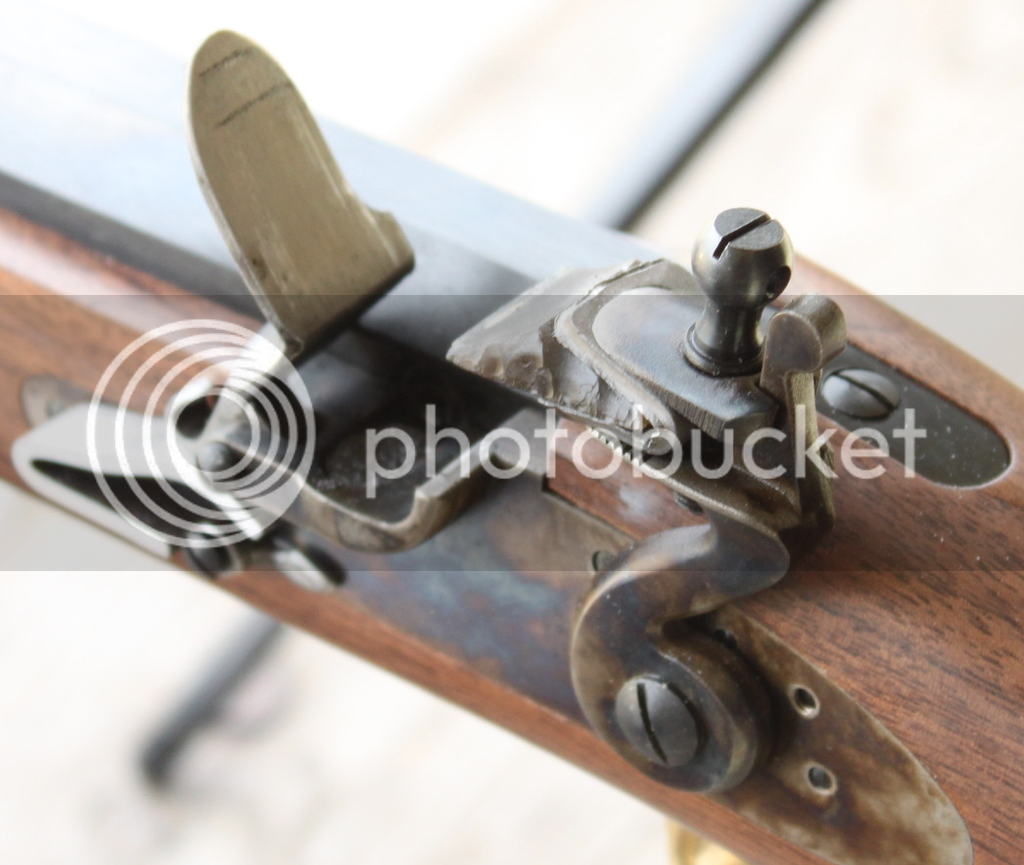
Loading.
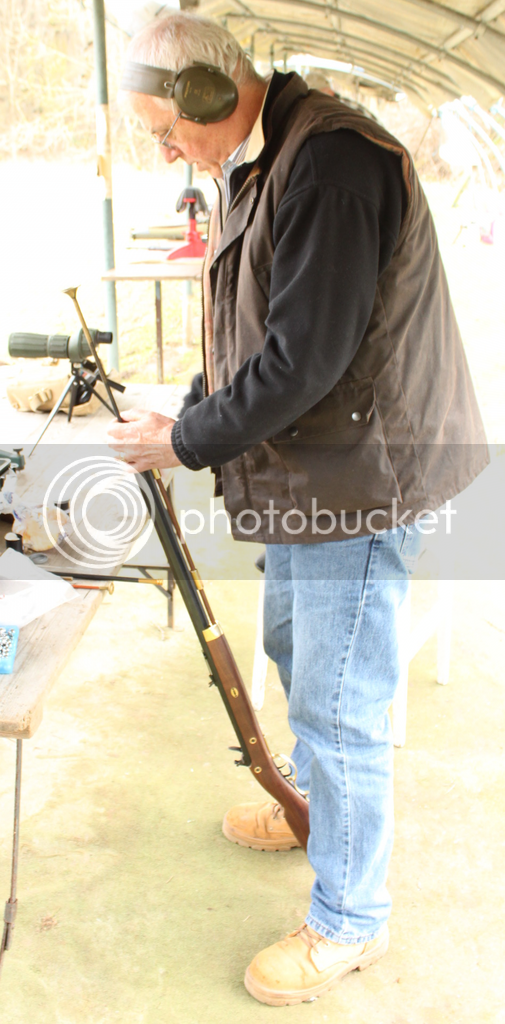
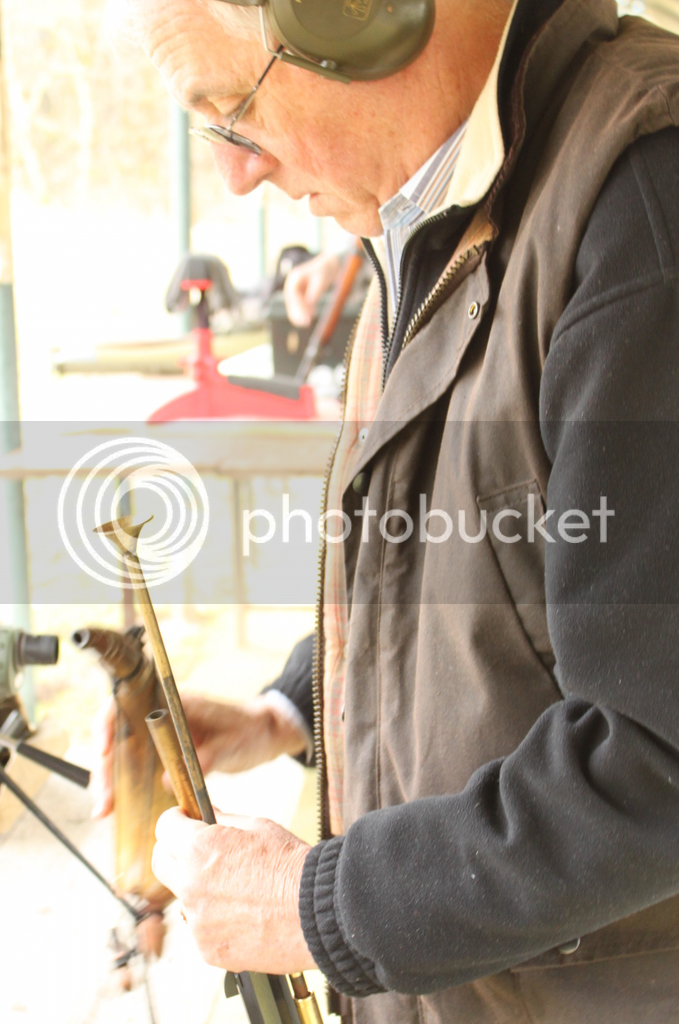
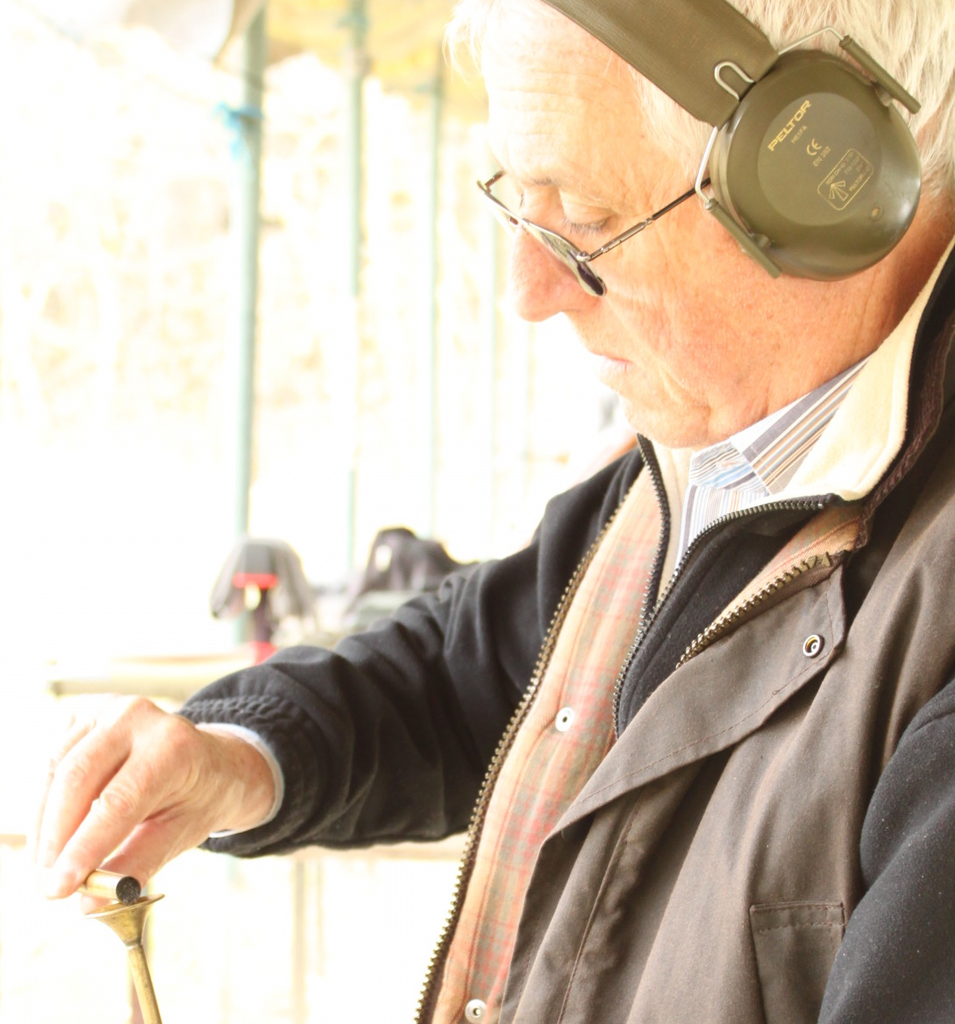
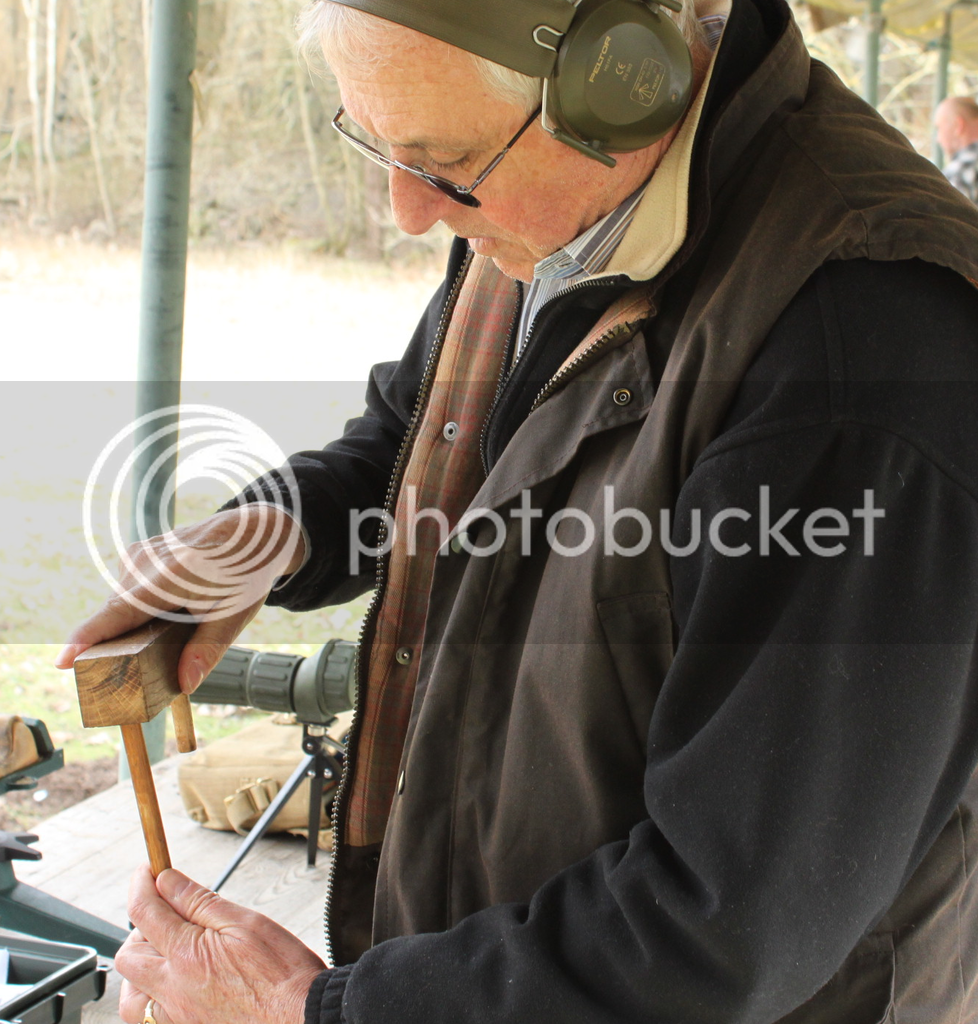
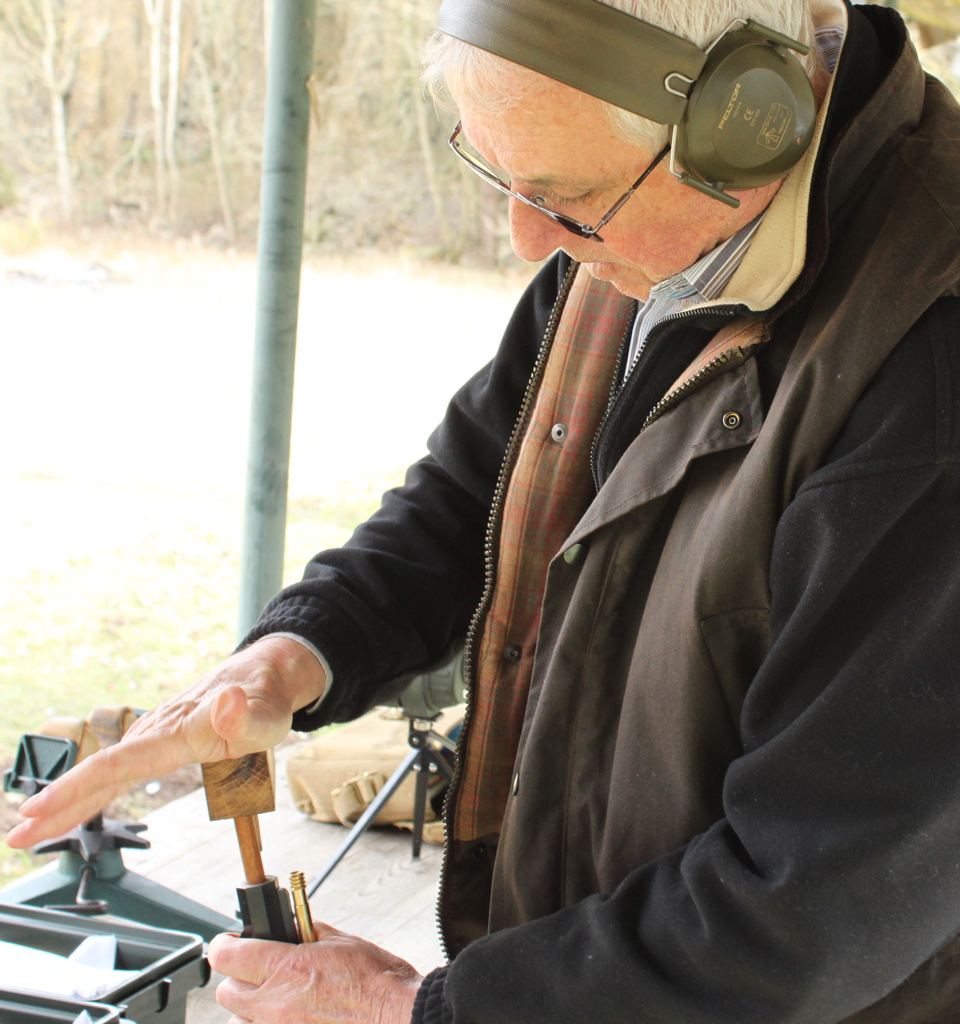
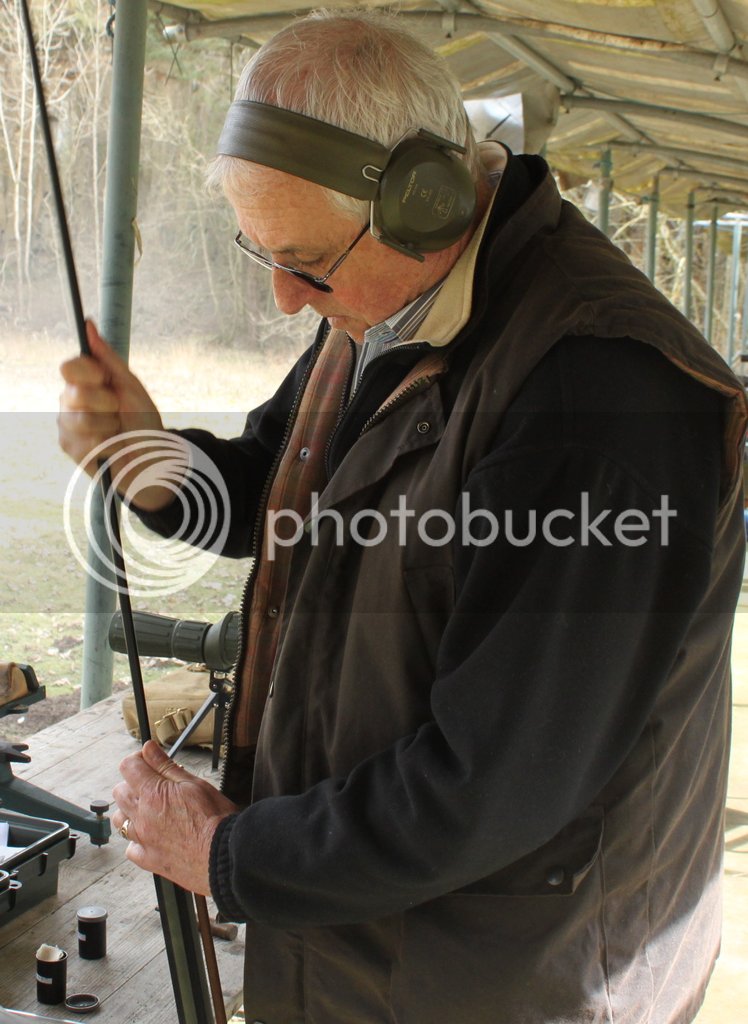
Priming the pan.
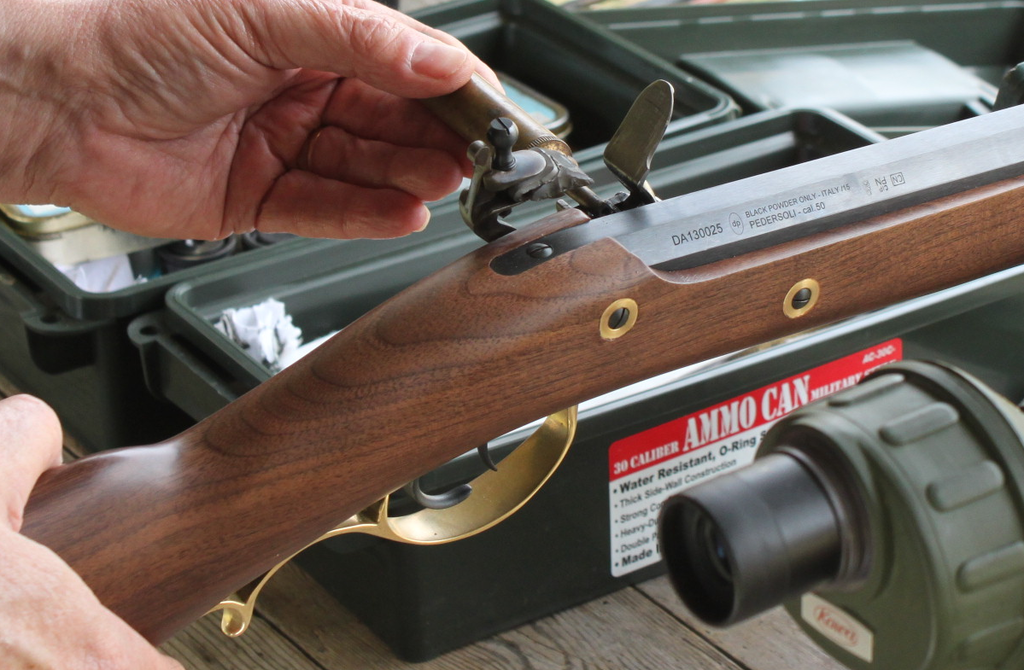
Firing.


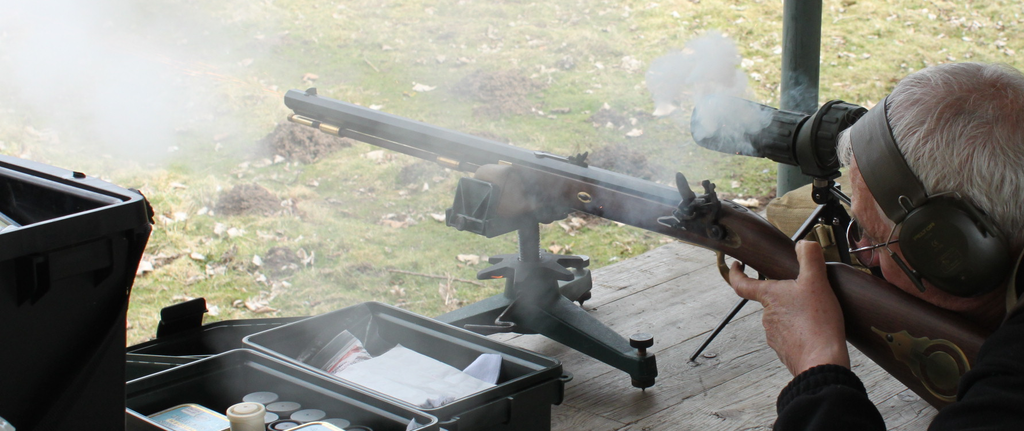
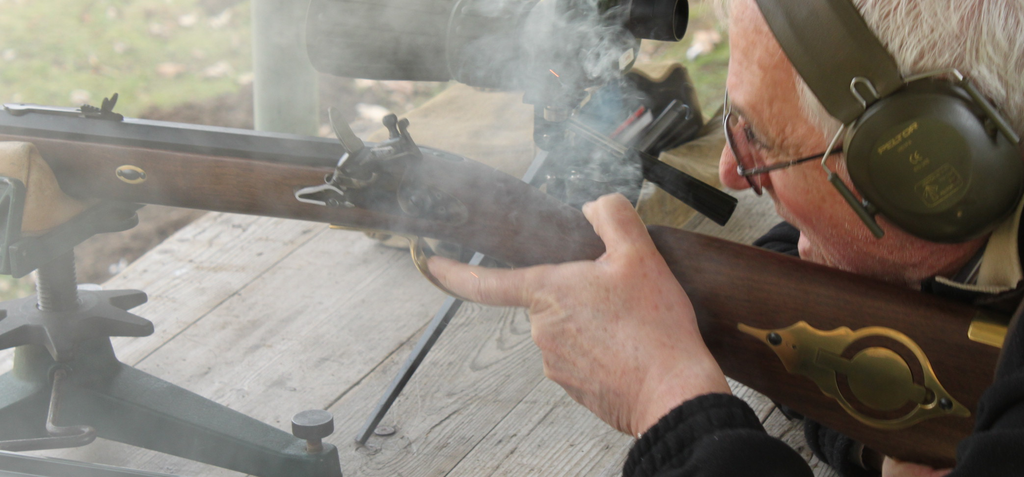
Even right handed people can shoot these guns.

All in all a very fine and affordable package from Pedersoli that will give any owner a gun they can be proud of that shoots very well straight out of the box.
The only complaint I have is that it shoots so well with the first picked load that I wonder what I will need to do for "load development", still that is just me."
"Well I thought I would take advantage of the glorious weather we are having to try out and zero the .54 calibre Investarms Flintlock "Hawken" I bought in the spring.
I picked this one up new in box from Krankies bin end sale for well under £200 so I didn't expect much from it.
Fit and finish isn't too bad just some places where the generic nature of the wood and metal are compromised for the different versions that they assemble for the yankee market.
The lock is a generic one taking a 3/4" flint, I binned the bit of slate that came with the gun and fitted 3/4" flint from Dysons.
I had the gun out shortly after I got it to try for function and shot it at 100 yrds. I had put around a dozen rounds through it. I was shooting it mainly to see how the lock did, what the pan liked and the loading regime needed to give consistent ignition. I was easily hitting the target at 100 yards but wasn't looking for groups or working on loading combinations. That is what I decide to start work on today.
The lock sparks well with a good, set up flint and the frizzen seems well hardened. Lock time isn't the fastest but not bad for a cheapy gun, there is just a slight pause 'tween squeezing the trigger and ignition. Interestingly this gun likes a full pan of priming powder, stacked away from the touch hole, which is bushed.
The barrel looks good nice and heavy, octagonal with the ubiqutous 1 in 48" twist, it is smooth with no rough patches when pushing down a cloth.
Sights are of a modern style with the rear sight adjustable for elevation and windage.
There is set trigger with a set let off at around three pounds.
For todays shooting I set the target up at 75 yards, shot standing using a tree stump as a rest.
I was using .534" cast lead balls and 0.012" Tanner patches dry lubed with Aquoil
I started with a load of 40 grains of Swiss fffg taking a six o clock hold on the target and they are the two bottom holes on the target.
I then moved up to 45 grains and shot the next four holes, I pulled the last one to the right as I had a hesitant ignition, the flint needed knapping and easing forward. These were shooting to point of aim just slightly to the right.
After fettling the flint the last two in the black were with 50 gns and showed promise but I had to pack in there as I was loosing the light.
I will start there again tomorrow weather permitting.
I am very pleased with this little flinter, it promises to be a lot of fun, seems to be quiet well behaved and nicely painless to get to shoot.
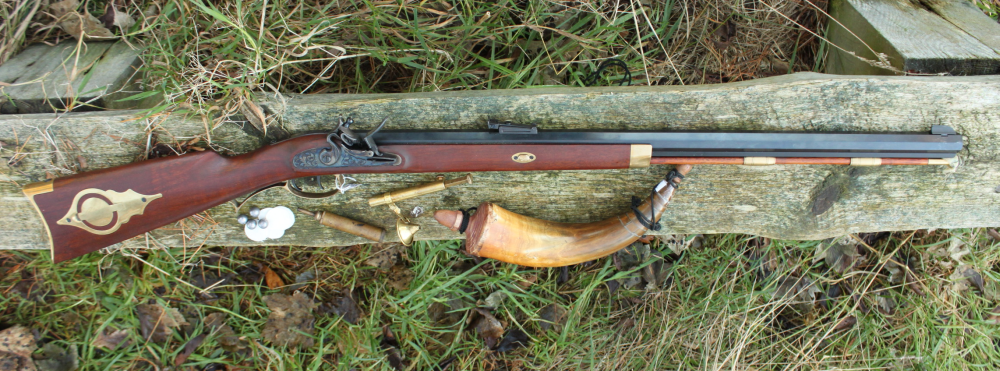
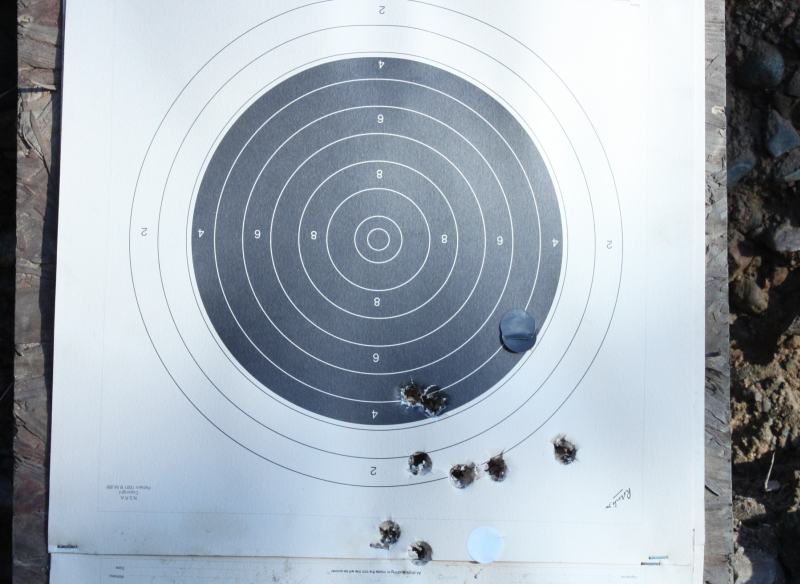
After the days of strong east winds we are back to glorious weather again, so the day before yesterday I had another session with this little flinter.
Moving on from the 50 grain fffg load with a dry lubed Tanner 0.012" patch and a 0.534" ball I upped the load to 55gns and shot this 75 yrd six shot group standing rested taking a six o clock hold at the bottom of the black.
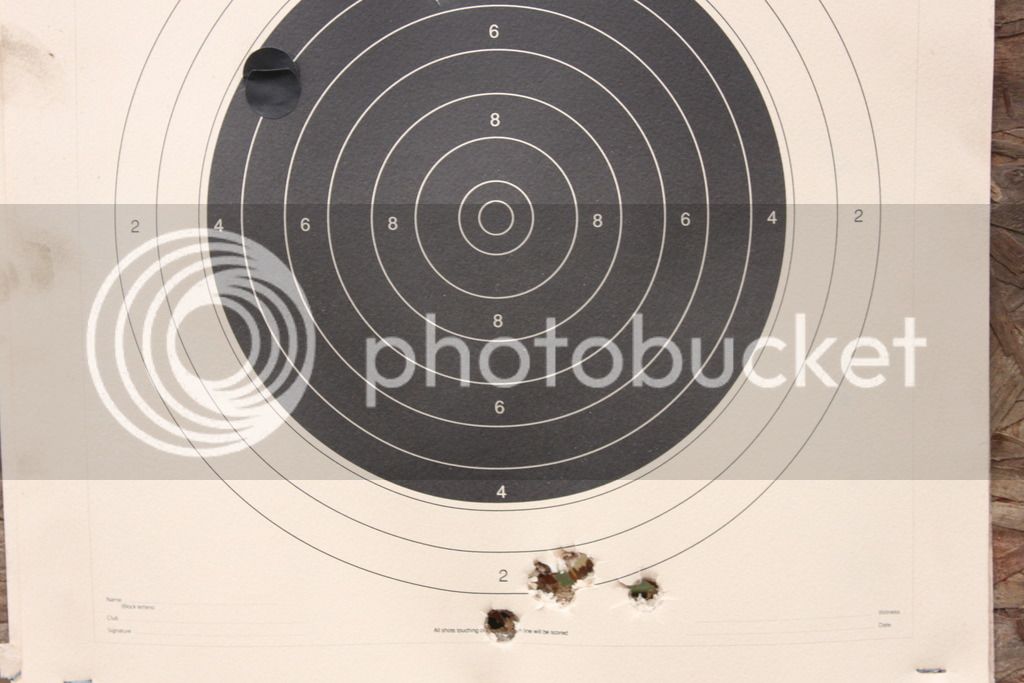
I then tried the same load with a 0.014" linen patch taking a centre hold on the bull and got this.
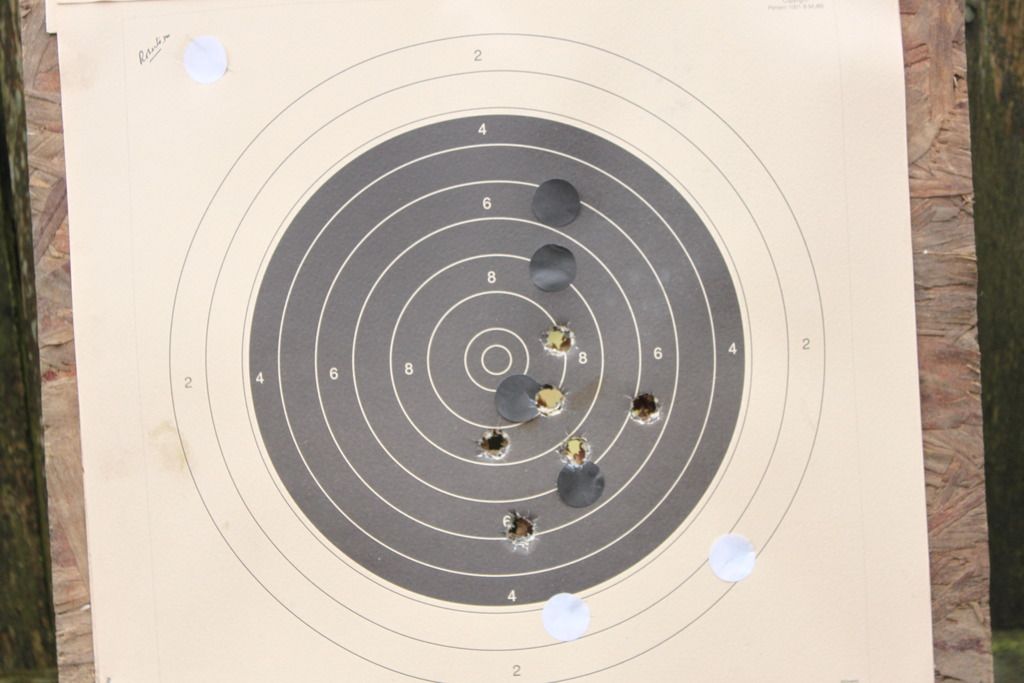
Looking at the fired patches they were blown, the 0.012" patches were showing some piercing at the lands so I suspect that with this being a new gun the rifling has some sharp edges that are cutting the patches when I an sending down the ball, a few passes down the barrel with a steel wool wrapped jag should fettle that.
I also suspect that the openness of that group was also due to the foresight floating in the black with the centre hold, even although the light was excellent the sight picture wasn't as sharp as the six-o-clock hold.
All in all this is one of the best shooting, value for money, acquisitions I have made in a long time and I am getting around 30 shots to a Dyson flint not bad and should do better with some better quality sparkers.
These eytie repro houses are turning out some excellent kit that definitely doesn't break the bank. Accurate, challenging, satisfying and fun shooting doesn't need to cost a lot."
Here are my experiences of each.
"I had a real treat on Tuesday I had one of Pedersoli's new Traditional "Hawken" Hunter Flintlock Rifle, .50 calibre in true left handed configuration to try out.
This is an interesting development for Pedersoli as it is at the low end of their price range with the L/H version coming in at around £480 in Kranks catalogue and the R/H slightly less.
As a left handed longarm shooter who has been shooting right handed rifles all my life I was particularly interested in trying out a true left handed gun, available at a friendly price and a flintlock to boot. Left handed guns are around but not many production guns are configured this way and those that are have a premium price.
The rifle looks very much like the Investarms "Hawken" that I got last year and reviewed on here. I suspect that Pedersoli has brought out this rifle to compete with the Investarms marketed by Lyman, along with the other budget European "Hawkens" being marketed in the US by the yankee black powder houses.
Of all the Eytie repro houses Pedersoli revel in the reputation of making for the high quality end of the market with production guns of theirs winning the medals in top international competitions. Pedersoli's high quality fit, finish and function is their trademark.
So how does this Pedersoli fair being their first excursion into the budget end of the market?
On initial inspection it stands out as a Pedersoli with the wood to metal finish being excellent especially around the lock and patch box, areas that are forgivably less than perfect on other budget guns, even the patch recess has been well finished inside unlike others that look as if they have been gouged out with a spade. The wood as some figuring, the lock plate has a case hardened finish with the blueing being deep and even. The barrel is octagonal with the ubiquitous 1:48 twist, the muzzle is crowned but it is quiet narrow so care has to be taken when seating patches so as not to nick and hole them. The rifle has buckhorn rear sights and a blade foresight, fortunately these are placed at distance that suit my eyes well so they give me a fine sight picture.
The barrel inside was heavily fouled from the proof house and it took quiet a while with many patches and copious amounts of Aquoil to get it cleaned, but when it was it was bright and shiny with crisp, even rifling that had no tight or rough spots when a tight dry patch was sent down.
It is fitted with a very nice set trigger that gives a crisp, light let off that contributes greatly to the guns grouping ability.
So how does Pedersoli get such quality in at such a low price? If we compare it to the other "Hawkens" in their range like the Rocky Mountain and Missouri models which go for around £250 more these rifles are shorter both in barrel length and in forend length with only one barrel wedge being need as opposed the two in the Missouri and Rocky Mountain models. Savings have been made by using less materials and what must be a simplified manufacturing process. This actually gives a handier rifle that will no doubt appeal once again to the yankee market where such guns are popular for the black powder hunting season.
Now we have have well made and finished gun that fits well and as lefty it is nice to have a cheek rest on the stock that I can use but all this is for naught if it doesn't perform on the target.
To test the rifle I set the target up at 50yrds and shot it benched from a front rest. I decided upon a starting load of 60 grains of Swiss fffg powder under a cast 0.495" lead ball on a 1" diameter 0.015" thick Tanner patch that was dry lubed with Aquoil. I used Swiss Nothing B powder in the priming pan. Sighting was taken with a six-o-clock hold.
Upon initial inspection the lock geometry looked odd in comparison to the accepted norms for good sparking locks, the flint was aligned high on the frizzen and was pointing well beyond the pan when fired, this was regardless of how the flint was fitted. Despite the contravention of accepted theory the lock functioned very well, the Pedersoli geometry gives for a short throw of the cock and I suspect that contributes in no small way to the rifles impressive rapidity of ignition. The flint that came with the rifle looked usable and gave around a dozen or so shots before it shattered, it could not be re-knapped and was replaced with a good quality English black flint which functioned flawlessly for the remaining three dozen or so shots and had plenty of life in it when I had finished, so with with a good flint I would be expecting at least 50 shots from it and no doubt a good many more beyond that. The original flint came seated in the cock jaws with lead sheeting which I retained rather than my usual leather, I suspect that the lead helps with the ignition by adding extra mass which helps with the cocks momentum in its short throw, then again I could just be over thinking it.
Loading was done using a short starter as this patch and ball combination is a tight fit, a Pro Shot black powder, flexible rod and a 50 calibre bp jag was used for all ramming, wiping and cleaning. These rods are excellent and I use them for all my muzzle loading. The rod that comes with the rifle is actually of good quality with the ferrules pinned and threaded for jags, the grain straight and aligned with length of the rod so I would have no hesitation in using it if I had to.
With the first load home it took three pans of priming powder before the first ignition, this was no doubt due to proof fouling lingering in the antechamber of Pedersoli's simplified patent breech. Over the 50 or so shots that were put through the rifle there were only two failures to fire and they were both due to forgetting to the prick the touch hole after seating the main charge.
Between shots the barrel had a barely damp Aquoiled patch put down after the powder followed by a dry patch to keep the bore in a consistent condition, there was no fouling build up and the patched ball seated smoothly each time with the barrel cleaning up at the end of shooting with half a dozen wet and dry patches. Good quality fine grade powder with a tight fitting dry patched ball all leads to efficient ignition and a minimum of fouling to manage.
Here is the target with first six shots, the first shot was high at twelve-o-clock the next two were where I was bringing the sights down with the last three going into the group at nine-o-clock, I was going to tap the foresight over when I noticed that my careless adjusting of the rear sight wedge had jammed over to the left 'tween the rearsight and the barrel thus causing the drift to the left with the first four shots, with this straightened the rifle then shot consistently into the nine ring at nine-o-clock so to get it "on" would only require a slight adjustment of the foresight. The rifle performed to this same point of impact when shot by two left handed shooters and one right hander, groups were "one hole" with all shooters, except for the odd ones out of the groups which in all cases were called by the firers.

The action.

Loading.






Priming the pan.

Firing.




Even right handed people can shoot these guns.

All in all a very fine and affordable package from Pedersoli that will give any owner a gun they can be proud of that shoots very well straight out of the box.
The only complaint I have is that it shoots so well with the first picked load that I wonder what I will need to do for "load development", still that is just me."
"Well I thought I would take advantage of the glorious weather we are having to try out and zero the .54 calibre Investarms Flintlock "Hawken" I bought in the spring.
I picked this one up new in box from Krankies bin end sale for well under £200 so I didn't expect much from it.
Fit and finish isn't too bad just some places where the generic nature of the wood and metal are compromised for the different versions that they assemble for the yankee market.
The lock is a generic one taking a 3/4" flint, I binned the bit of slate that came with the gun and fitted 3/4" flint from Dysons.
I had the gun out shortly after I got it to try for function and shot it at 100 yrds. I had put around a dozen rounds through it. I was shooting it mainly to see how the lock did, what the pan liked and the loading regime needed to give consistent ignition. I was easily hitting the target at 100 yards but wasn't looking for groups or working on loading combinations. That is what I decide to start work on today.
The lock sparks well with a good, set up flint and the frizzen seems well hardened. Lock time isn't the fastest but not bad for a cheapy gun, there is just a slight pause 'tween squeezing the trigger and ignition. Interestingly this gun likes a full pan of priming powder, stacked away from the touch hole, which is bushed.
The barrel looks good nice and heavy, octagonal with the ubiqutous 1 in 48" twist, it is smooth with no rough patches when pushing down a cloth.
Sights are of a modern style with the rear sight adjustable for elevation and windage.
There is set trigger with a set let off at around three pounds.
For todays shooting I set the target up at 75 yards, shot standing using a tree stump as a rest.
I was using .534" cast lead balls and 0.012" Tanner patches dry lubed with Aquoil
I started with a load of 40 grains of Swiss fffg taking a six o clock hold on the target and they are the two bottom holes on the target.
I then moved up to 45 grains and shot the next four holes, I pulled the last one to the right as I had a hesitant ignition, the flint needed knapping and easing forward. These were shooting to point of aim just slightly to the right.
After fettling the flint the last two in the black were with 50 gns and showed promise but I had to pack in there as I was loosing the light.
I will start there again tomorrow weather permitting.
I am very pleased with this little flinter, it promises to be a lot of fun, seems to be quiet well behaved and nicely painless to get to shoot.


After the days of strong east winds we are back to glorious weather again, so the day before yesterday I had another session with this little flinter.
Moving on from the 50 grain fffg load with a dry lubed Tanner 0.012" patch and a 0.534" ball I upped the load to 55gns and shot this 75 yrd six shot group standing rested taking a six o clock hold at the bottom of the black.

I then tried the same load with a 0.014" linen patch taking a centre hold on the bull and got this.

Looking at the fired patches they were blown, the 0.012" patches were showing some piercing at the lands so I suspect that with this being a new gun the rifling has some sharp edges that are cutting the patches when I an sending down the ball, a few passes down the barrel with a steel wool wrapped jag should fettle that.
I also suspect that the openness of that group was also due to the foresight floating in the black with the centre hold, even although the light was excellent the sight picture wasn't as sharp as the six-o-clock hold.
All in all this is one of the best shooting, value for money, acquisitions I have made in a long time and I am getting around 30 shots to a Dyson flint not bad and should do better with some better quality sparkers.
These eytie repro houses are turning out some excellent kit that definitely doesn't break the bank. Accurate, challenging, satisfying and fun shooting doesn't need to cost a lot."
I know this is a old thread, but what did you do to remove the barrel? I have a Pedersoli Traditional Hawken on the way, & I just found out, it doesn't have a hooked breach for easy barrel removal. Any information will be greatly appreciated.Thank you Denball. I was getting ready to return it and then I tried what you recommended and it worked.
Thanks again. Jim
Tasbay
40 Cal
I have had the barrel out of mine once when I sanded down the varnish finish and oiled the stock. Took ramrod , wedge pin out along with tang screw and that was about it from memory, don`t remember it being difficult. I just clean the barrel in place. Have never had an issue with the rifle or cleaning it..
Similar threads
- Replies
- 2
- Views
- 274
- Replies
- 9
- Views
- 492




